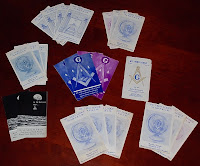There are huge plans afoot in New Jersey Scottish Rite Masonry that will reverberate throughout the Northern Masonic Jurisdiction in 2012, and these plans all concern teaching Scottish Rite Masons what it means to be Scottish Rite Masons. (The event advertised in the graphic above is not one of them. It's only a hint of what's to come. A far more substantial, but still inconclusive, clue is found here.)
Sounds simple, right? Like it might be the primary reason and most frequent activity of the fraternity? Nah, didn't work out that way. Teaching Scottish Rite Masons what it means to be Scottish Rite Masons actually is a pursuit that has to be pitched, lobbied for, protected, and seen to fruition flawlessly, so that a follow-up effort even can be worthy of discussion. It's a sad state of affairs for what used to be called the College of Freemasonry, but after so many decades of the Shrinerization of Freemasonry, this is where we are. For now.
This Stated Meeting of New Jersey Consistory will be the first meeting convened since our initiation of about twenty brethren in November. In fact, it is inspired by one of those new 32° Masons. He exited the auditorium after the completion of the Camp Scene explanation, and asked Bro. Mohamad a question about the numerology of the Camp. The two then approached me at the secretary's table, where I was stamping passports and handing out membership packets, and put the question to me. I was mortified. Engrossed in the humdrum of stamping this passport, stuffing that envelope, and otherwise administrating the minutiae, I couldn't answer a simple question on the spot.
And so, the inspiration of this event on January 10.
It will be a tiled lecture for 32° Masons only, but not just for New Jersey Consistory brethren. In fact, the guest list includes several Scottish Rite Masons from Pennsylvania already.
The bad news is the lecturer will be me. If you can withstand that, please join us for a philosophical exploration of the allegorical story of Constans, which some have not even seen yet, and a more temporal definition of the Camp Scene, which at the very least will answer that brother's question.



























































































